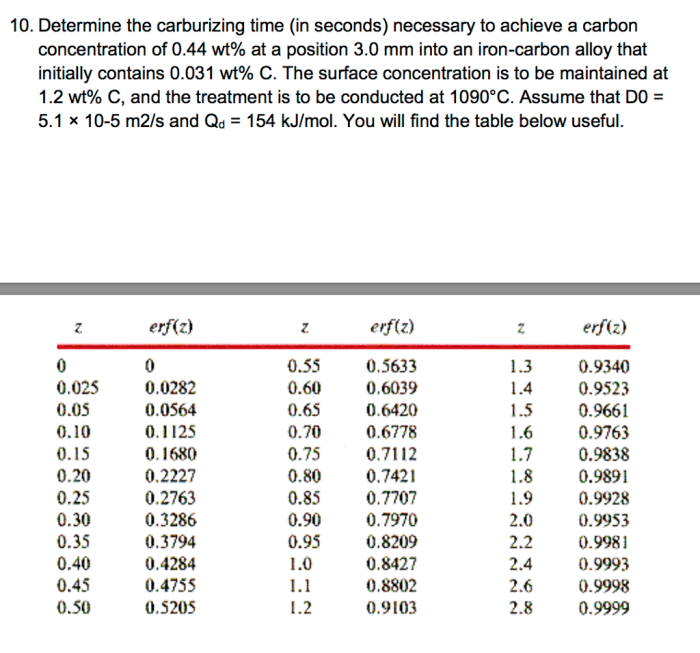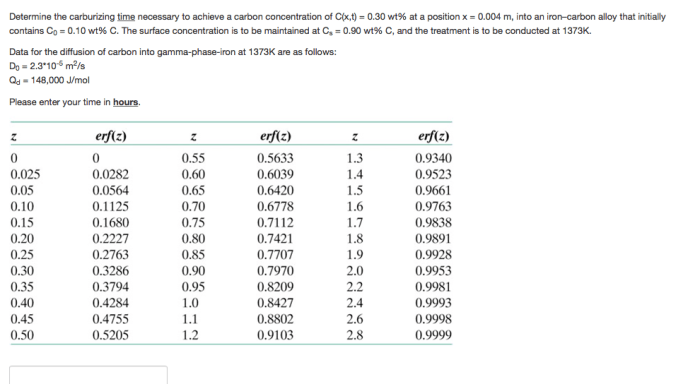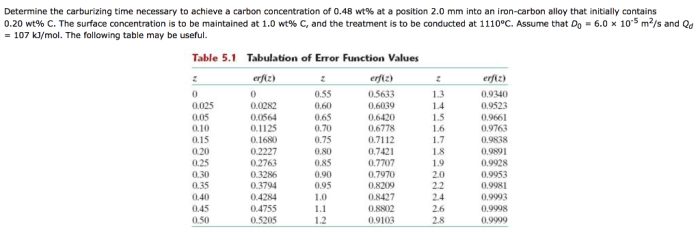Determine the carburizing time necessary to achieve a carbon content is a crucial aspect of carburizing, a heat treatment process that enhances the surface properties of steel components. This process involves infusing carbon into the steel’s surface, creating a hardened case with improved wear resistance, fatigue strength, and other desirable characteristics.
Understanding the factors influencing carburizing time is essential for optimizing the process and achieving the desired results. These factors include surface carbon content, carburizing atmosphere, temperature, and steel grade. By carefully considering these parameters, manufacturers can tailor the carburizing process to meet specific application requirements.
Carburizing: A Comprehensive Overview

Carburizing is a heat treatment process that increases the carbon content of the surface of a steel component. This process results in a harder, wear-resistant surface while maintaining a softer, more ductile core. Carburizing is widely used in various industries, including automotive, aerospace, and manufacturing.
Surface Carbon Content

Surface carbon content is a critical factor in carburizing as it directly affects the properties of the carburized component. A higher surface carbon content results in a harder and more wear-resistant surface. However, excessive surface carbon content can lead to brittleness and reduced toughness.
Examples of how surface carbon content affects the properties of carburized components include:
- Increased wear resistance in gears and bearings
- Improved fatigue strength in crankshafts and connecting rods
- Enhanced cutting performance in cutting tools
Carburizing Atmosphere
The carburizing atmosphere is a critical factor that influences the rate of carbon absorption and the final surface carbon content. Different types of carburizing atmospheres include:
- Endothermic atmosphere: Produces a carbon potential of 0.8-1.2%
- Exothermic atmosphere: Produces a carbon potential of 1.2-1.6%
- Neutral atmosphere: Produces a carbon potential of less than 0.2%
Controlling the carbon potential of the carburizing atmosphere is essential to achieve the desired surface carbon content.
Carburizing Temperature: Determine The Carburizing Time Necessary To Achieve A Carbon

Carburizing temperature is another important factor that affects the rate of carbon absorption. Higher carburizing temperatures result in faster carbon absorption and deeper case depths. However, excessive temperatures can lead to grain growth and reduced toughness.
Selecting the appropriate carburizing temperature for a given application requires consideration of the desired case depth, the steel grade, and the carburizing atmosphere.
Carburizing Time
Carburizing time is calculated to achieve a desired case depth. The following formula can be used to estimate the carburizing time:
Carburizing time (hours) = (Case depth (mm))^2 / (Diffusion coefficient (mm^2/s) – Carburizing temperature (K))
The diffusion coefficient is a material property that depends on the steel grade and the carburizing atmosphere.
Case Depth
Case depth is the depth of the hardened surface layer in a carburized component. It is important because it determines the wear resistance and fatigue strength of the component.
Different methods for measuring case depth include:
- Microhardness testing
- Metallographic examination
- Eddy current testing
Microstructure of Carburized Components
The microstructure of carburized components consists of a hard and wear-resistant case and a softer and more ductile core. The case region typically exhibits a martensitic or bainitic structure, while the core region has a ferritic or pearlitic structure.
The microstructure of carburized components affects their properties. The hard case provides wear resistance, while the softer core provides toughness and ductility.
Applications of Carburizing
Carburizing is used in a wide range of applications where improved wear resistance and fatigue strength are required. Some examples include:
- Gears and bearings
- Crankshafts and connecting rods
- Cutting tools
- Camshafts
- Axles
Advantages of carburizing include improved wear resistance, increased fatigue strength, and enhanced cutting performance. Disadvantages include the potential for distortion and the need for post-heat treatment operations.
Query Resolution
What is the significance of surface carbon content in carburizing?
Surface carbon content is crucial in carburizing as it determines the hardness, wear resistance, and fatigue strength of the carburized component.
How does carburizing temperature affect the carburizing process?
Carburizing temperature influences the rate of carbon absorption and the depth of the carburized case. Higher temperatures generally result in faster carbon absorption and deeper case depths.
What factors influence the carburizing time?
Carburizing time is affected by factors such as the steel grade, carburizing temperature, carburizing atmosphere, and desired case depth.